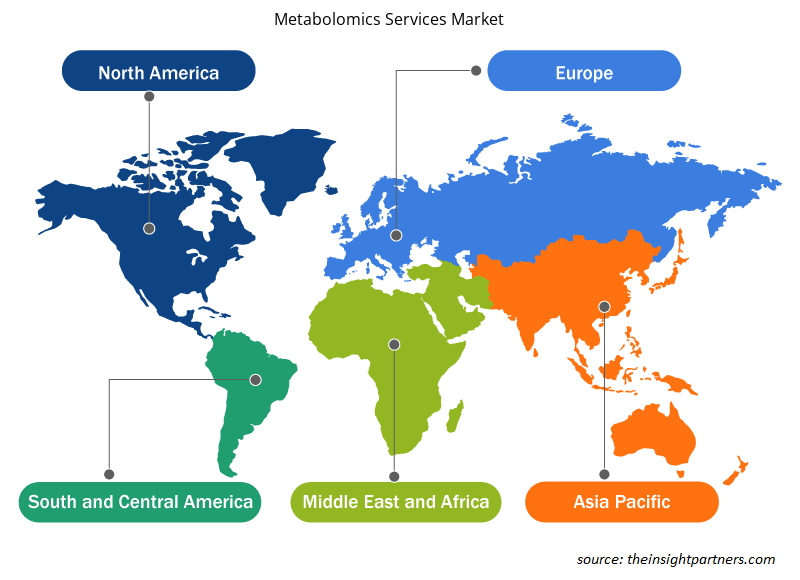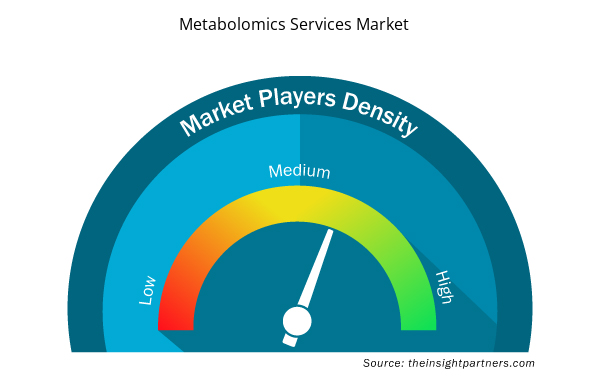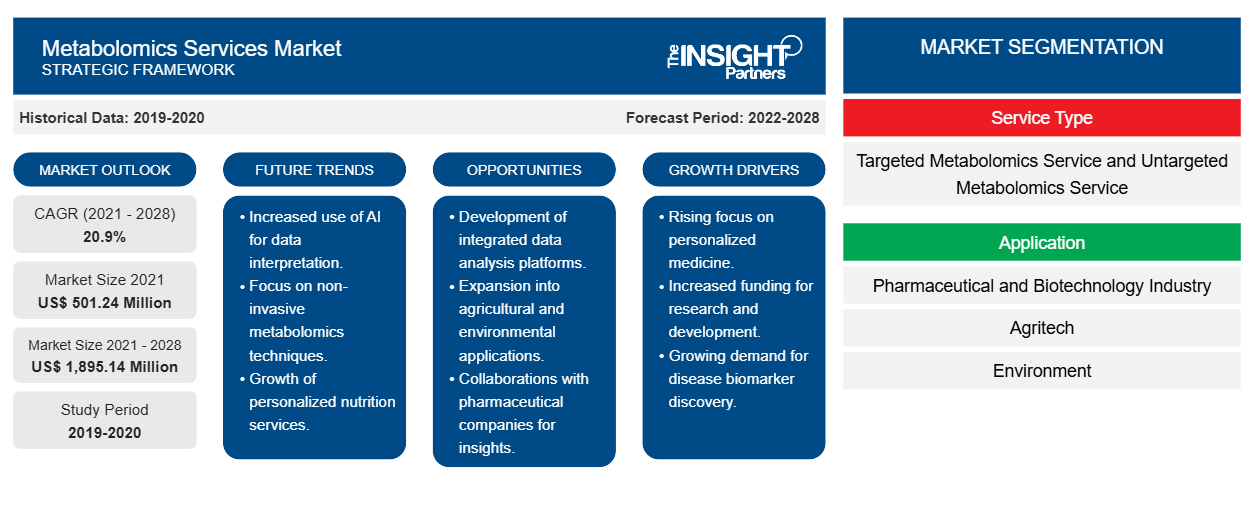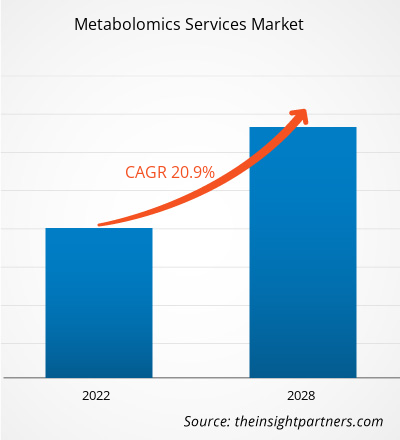[Forschungsbericht] Der Markt für Metabolomik-Dienstleistungen soll von 501,24 Millionen US-Dollar im Jahr 2021 auf 1.895,14 Millionen US-Dollar im Jahr 2028 anwachsen; von 2021 bis 2028 wird mit einer durchschnittlichen jährlichen Wachstumsrate von 20,9 % gerechnet.
Die Metabolomik ist die Untersuchung und Analyse biologischer Prozesse, an denen Stoffwechselzwischenprodukte und -nebenprodukte beteiligt sind – die Metabolome. Zu den Metabolomen zählen sekundäre Metabolite, Signalmoleküle, Hormone und Stoffwechselzwischenprodukte.
Der Bericht bietet eine eingehende Analyse des Marktes für Metabolomik-Dienstleistungen und legt dabei den Schwerpunkt auf Markttrends, technologische Fortschritte, Marktdynamik und Wettbewerbslandschaft (unter Beteiligung wichtiger Marktteilnehmer auf der ganzen Welt). Er umfasst auch die Auswirkungen der COVID-19-Pandemie auf den Markt in allen wichtigen Regionen. Nordamerika hält den größten Marktanteil, und das Marktwachstum in dieser Region ist auf die hohe Bekanntheit und Akzeptanz von Metabolomik-Dienstleistungen, die zunehmende Anzahl von Online-Einzelhändlern und die steigende Anzahl von Produktinnovationen und -einführungen zurückzuführen. Darüber hinaus dürften sich die wachsenden Ausgaben von Sextechnologieunternehmen im Prognosezeitraum auch positiv auf den nordamerikanischen Markt für Metabolomik-Dienstleistungen auswirken. Der Markt ist nach Regionen in Nordamerika, Europa, Asien-Pazifik (APAC), den Nahen Osten und Afrika (MEA) sowie Süd- und Mittelamerika (SAM) unterteilt.
Passen Sie diesen Bericht Ihren Anforderungen an
Sie erhalten kostenlose Anpassungen an jedem Bericht, einschließlich Teilen dieses Berichts oder einer Analyse auf Länderebene, eines Excel-Datenpakets sowie tolle Angebote und Rabatte für Start-ups und Universitäten.
- Holen Sie sich die wichtigsten Markttrends aus diesem Bericht.Dieses KOSTENLOSE Beispiel umfasst eine Datenanalyse von Markttrends bis hin zu Schätzungen und Prognosen.
Markteinblicke
Steigende Krebserkrankungen beflügeln Wachstum im Markt für Metabolomik-Dienstleistungen
Die Metabolomik gehört zu den wachsenden und robusten Technologien zur Erkennung einer breiten Palette von Metaboliten in Geweben und Bioflüssigkeiten. Dieses Verfahren findet eine bedeutende Anwendung in der Analyse und Erforschung von Krebserkrankungen. Die steigende Prävalenz verschiedener Krebsarten wird den Markt im Prognosezeitraum voraussichtlich antreiben. Die Krebsdiagnostik spielt eine wesentliche Rolle bei der Krebsbehandlung. Laut den im September 2021 von der Weltgesundheitsorganisation (WHO) veröffentlichten Daten wurden fast 70 % der Todesfälle durch Krebs in Ländern mit niedrigem und mittlerem Einkommen auf der ganzen Welt gemeldet. Der weltweite Anteil der Krebsinzidenz beträgt laut Aufzeichnungen des Global Cancer Observatory Brustkrebs (2,26 Millionen Fälle 11,7 %), Lungenkrebs (2,21 Millionen Fälle 11,4 %), Dickdarm und Mastdarm (1,93 Millionen Fälle 10 %), Prostatakrebs (1,41 Millionen Fälle 7,3 %) und Magenkrebs (1,09 Millionen Fälle 5,6 %). Nachfolgend finden Sie die Einzelheiten zur regionalen Prävalenz im Jahr 2020:
- Dieses KOSTENLOSE Beispiel umfasst eine Datenanalyse von Markttrends bis hin zu Schätzungen und Prognosen.
Servicetypbasierte Einblicke
Der Markt für Metabolomik-Dienste wurde je nach Diensttyp in zielgerichtete Metabolomik-Dienste und nicht zielgerichtete Metabolomik-Dienste segmentiert. Das Segment der zielgerichteten Metabolomik-Dienste dürfte 2021 einen größeren Marktanteil halten. Darüber hinaus wird erwartet, dass das Segment der zielgerichteten Metabolomik-Dienste im Prognosezeitraum eine höhere durchschnittliche jährliche Wachstumsrate (CAGR) auf dem Markt verzeichnet.
Anwendungsbasierte Erkenntnisse
Der Markt für Metabolomik-Dienstleistungen ist je nach Anwendung in die Bereiche Pharma- und Biotechnologie, Agrartechnologie und Umwelt unterteilt. Das Segment Pharma- und Biotechnologie wird voraussichtlich im Jahr 2021 den größten Marktanteil halten. Darüber hinaus wird erwartet, dass der Markt für dieses Segment im Zeitraum von 2021 bis 2028 mit einer durchschnittlichen jährlichen Wachstumsrate von 21,6 % am schnellsten wächst.
Die Akteure auf dem Markt für Metabolomik-Dienstleistungen verfolgen organische Strategien wie Produkteinführung und -expansion, um ihre globale Präsenz und ihr Produktportfolio zu erweitern.
Regionale Einblicke in den Markt für Metabolomik-Dienste
Die regionalen Trends und Faktoren, die den Markt für Metabolomics-Dienste im Prognosezeitraum beeinflussen, wurden von den Analysten von Insight Partners ausführlich erläutert. In diesem Abschnitt werden auch die Marktsegmente und die Geografie von Metabolomics-Diensten in Nordamerika, Europa, im asiatisch-pazifischen Raum, im Nahen Osten und Afrika sowie in Süd- und Mittelamerika erörtert.

- Erhalten Sie regionale Daten zum Markt für Metabolomics-Dienstleistungen
Umfang des Marktberichts zu Metabolomik-Dienstleistungen
| Berichtsattribut | Details |
|---|---|
| Marktgröße im Jahr 2021 | 501,24 Millionen US-Dollar |
| Marktgröße bis 2028 | 1.895,14 Millionen US-Dollar |
| Globale CAGR (2021 - 2028) | 20,9 % |
| Historische Daten | 2019-2020 |
| Prognosezeitraum | 2022–2028 |
| Abgedeckte Segmente | Nach Servicetyp
|
| Abgedeckte Regionen und Länder | Nordamerika
|
| Marktführer und wichtige Unternehmensprofile |
|
Marktteilnehmerdichte: Der Einfluss auf die Geschäftsdynamik
Der Markt für Metabolomics-Dienstleistungen wächst rasant. Dies wird durch die steigende Nachfrage der Endnutzer aufgrund von Faktoren wie sich entwickelnden Verbraucherpräferenzen, technologischen Fortschritten und einem größeren Bewusstsein für die Vorteile des Produkts vorangetrieben. Mit der steigenden Nachfrage erweitern Unternehmen ihr Angebot, entwickeln Innovationen, um die Bedürfnisse der Verbraucher zu erfüllen, und nutzen neue Trends, was das Marktwachstum weiter ankurbelt.
Die Marktteilnehmerdichte bezieht sich auf die Verteilung der Firmen oder Unternehmen, die in einem bestimmten Markt oder einer bestimmten Branche tätig sind. Sie gibt an, wie viele Wettbewerber (Marktteilnehmer) in einem bestimmten Marktraum im Verhältnis zu seiner Größe oder seinem gesamten Marktwert präsent sind.
Die wichtigsten auf dem Markt für Metabolomik-Dienstleistungen tätigen Unternehmen sind:
- BASF SE
- TMIC
- Kreative Proteomik
- BGI
- RTI International
Haftungsausschluss : Die oben aufgeführten Unternehmen sind nicht in einer bestimmten Reihenfolge aufgeführt.

- Überblick über die wichtigsten Akteure auf dem Markt für Metabolomik-Dienstleistungen
Nach Servicetyp
- Gezielter Metabolomik-Dienst
- Dienst für nicht zielgerichtete Metabolomik
Nach Anwendung
- Pharmazeutische und biotechnologische Industrie
- Biomarker-Erkennung
- Arzneimittelforschung
- Toxikologische Tests
- Sonstiges
- Agrartechnik
- Umfeld
Von
Geographie
Nordamerika
- UNS
- Kanada
- Mexiko
Europa
- Frankreich
- Deutschland
- Italien
- Vereinigtes Königreich
- Spanien
- Restliches Europa
Asien-Pazifik (APAC)
- China
- Indien
- Südkorea
- Japan
- Australien
- Restlicher Asien-Pazifik-Raum
Naher Osten und Afrika (MEA)
- Südafrika
- Saudi-Arabien
- Vereinigte Arabische Emirate
- Rest von MEA
Süd- und Mittelamerika (SCAM)
- Brasilien
- Argentinien
- Rest von SCAM
Firmenprofile
- BASF SE
- TMIC
- Kreative Proteomik
- BGI
- RTI International
- Afekta Technologies Ltd.
- Fred Hutchinson Krebsforschungszentrum
- Westküste Metabolomics Center
- Molekulares Ich
- Metabolon, Inc.
- biocrates life sciences ag
- Chenomx Inc.
- C-CAMP
- metaSysX
- MS-Omics
- Historische Analyse (2 Jahre), Basisjahr, Prognose (7 Jahre) mit CAGR
- PEST- und SWOT-Analyse
- Marktgröße Wert/Volumen – Global, Regional, Land
- Branche und Wettbewerbsumfeld
- Excel-Datensatz


- Green Hydrogen Market
- Rugged Phones Market
- Print Management Software Market
- Adaptive Traffic Control System Market
- Single-Use Negative Pressure Wound Therapy Devices Market
- Quantitative Structure-Activity Relationship (QSAR) Market
- Digital Pathology Market
- Cut Flowers Market
- Customer Care BPO Market
- Rare Neurological Disease Treatment Market

Report Coverage
Revenue forecast, Company Analysis, Industry landscape, Growth factors, and Trends

Segment Covered
This text is related
to segments covered.

Regional Scope
North America, Europe, Asia Pacific, Middle East & Africa, South & Central America

Country Scope
This text is related
to country scope.
Häufig gestellte Fragen
Metabolomics is the study and analysis of biological processes involving metabolic intermediates and byproducts. These products are referred to as metabolomes, and they contain all metabolites involved in an organism's many processes, including secondary metabolites, signalling molecules, hormones, and metabolic intermediates.
North America held highest market share in 2021.
Key factors that are driving growth of the market are rising incidences of cancer and increasing adoption of metabolomics and investments by market players. However, high cost of tools, instruments, and usage is expected to restrict the market growth during the forecast period.
BASF SE and TMIC .are the key players in the Metabolomics Services market
Targeted metabolomics service segment market provides the most opportunity for growth
The Metabolomics Services market is anticipated to grow around 20.9% CAGR amid the forecast period 2021-2028.
The List of Companies - Metabolomics Services Market
- BASF SE
- TMIC
- Creative Proteomics
- BGI
- RTI International
- Afekta Technologies Ltd.
- Fred Hutchinson Cancer Research Center
- West Coast Metabolomics Center
- Molecular You
- Metabolon, Inc.
- biocrates life sciences ag
- Chenomx Inc.
- C-CAMP
- metaSysX
- MS-Omics
The Insight Partners performs research in 4 major stages: Data Collection & Secondary Research, Primary Research, Data Analysis and Data Triangulation & Final Review.
- Data Collection and Secondary Research:
As a market research and consulting firm operating from a decade, we have published and advised several client across the globe. First step for any study will start with an assessment of currently available data and insights from existing reports. Further, historical and current market information is collected from Investor Presentations, Annual Reports, SEC Filings, etc., and other information related to company’s performance and market positioning are gathered from Paid Databases (Factiva, Hoovers, and Reuters) and various other publications available in public domain.
Several associations trade associates, technical forums, institutes, societies and organization are accessed to gain technical as well as market related insights through their publications such as research papers, blogs and press releases related to the studies are referred to get cues about the market. Further, white papers, journals, magazines, and other news articles published in last 3 years are scrutinized and analyzed to understand the current market trends.
- Primary Research:
The primarily interview analysis comprise of data obtained from industry participants interview and answers to survey questions gathered by in-house primary team.
For primary research, interviews are conducted with industry experts/CEOs/Marketing Managers/VPs/Subject Matter Experts from both demand and supply side to get a 360-degree view of the market. The primary team conducts several interviews based on the complexity of the markets to understand the various market trends and dynamics which makes research more credible and precise.
A typical research interview fulfils the following functions:
- Provides first-hand information on the market size, market trends, growth trends, competitive landscape, and outlook
- Validates and strengthens in-house secondary research findings
- Develops the analysis team’s expertise and market understanding
Primary research involves email interactions and telephone interviews for each market, category, segment, and sub-segment across geographies. The participants who typically take part in such a process include, but are not limited to:
- Industry participants: VPs, business development managers, market intelligence managers and national sales managers
- Outside experts: Valuation experts, research analysts and key opinion leaders specializing in the electronics and semiconductor industry.
Below is the breakup of our primary respondents by company, designation, and region:

Once we receive the confirmation from primary research sources or primary respondents, we finalize the base year market estimation and forecast the data as per the macroeconomic and microeconomic factors assessed during data collection.
- Data Analysis:
Once data is validated through both secondary as well as primary respondents, we finalize the market estimations by hypothesis formulation and factor analysis at regional and country level.
- Macro-Economic Factor Analysis:
We analyse macroeconomic indicators such the gross domestic product (GDP), increase in the demand for goods and services across industries, technological advancement, regional economic growth, governmental policies, the influence of COVID-19, PEST analysis, and other aspects. This analysis aids in setting benchmarks for various nations/regions and approximating market splits. Additionally, the general trend of the aforementioned components aid in determining the market's development possibilities.
- Country Level Data:
Various factors that are especially aligned to the country are taken into account to determine the market size for a certain area and country, including the presence of vendors, such as headquarters and offices, the country's GDP, demand patterns, and industry growth. To comprehend the market dynamics for the nation, a number of growth variables, inhibitors, application areas, and current market trends are researched. The aforementioned elements aid in determining the country's overall market's growth potential.
- Company Profile:
The “Table of Contents” is formulated by listing and analyzing more than 25 - 30 companies operating in the market ecosystem across geographies. However, we profile only 10 companies as a standard practice in our syndicate reports. These 10 companies comprise leading, emerging, and regional players. Nonetheless, our analysis is not restricted to the 10 listed companies, we also analyze other companies present in the market to develop a holistic view and understand the prevailing trends. The “Company Profiles” section in the report covers key facts, business description, products & services, financial information, SWOT analysis, and key developments. The financial information presented is extracted from the annual reports and official documents of the publicly listed companies. Upon collecting the information for the sections of respective companies, we verify them via various primary sources and then compile the data in respective company profiles. The company level information helps us in deriving the base number as well as in forecasting the market size.
- Developing Base Number:
Aggregation of sales statistics (2020-2022) and macro-economic factor, and other secondary and primary research insights are utilized to arrive at base number and related market shares for 2022. The data gaps are identified in this step and relevant market data is analyzed, collected from paid primary interviews or databases. On finalizing the base year market size, forecasts are developed on the basis of macro-economic, industry and market growth factors and company level analysis.
- Data Triangulation and Final Review:
The market findings and base year market size calculations are validated from supply as well as demand side. Demand side validations are based on macro-economic factor analysis and benchmarks for respective regions and countries. In case of supply side validations, revenues of major companies are estimated (in case not available) based on industry benchmark, approximate number of employees, product portfolio, and primary interviews revenues are gathered. Further revenue from target product/service segment is assessed to avoid overshooting of market statistics. In case of heavy deviations between supply and demand side values, all thes steps are repeated to achieve synchronization.
We follow an iterative model, wherein we share our research findings with Subject Matter Experts (SME’s) and Key Opinion Leaders (KOLs) until consensus view of the market is not formulated – this model negates any drastic deviation in the opinions of experts. Only validated and universally acceptable research findings are quoted in our reports.
We have important check points that we use to validate our research findings – which we call – data triangulation, where we validate the information, we generate from secondary sources with primary interviews and then we re-validate with our internal data bases and Subject matter experts. This comprehensive model enables us to deliver high quality, reliable data in shortest possible time.


 Holen Sie sich ein kostenloses Muster für diesen Bericht
Holen Sie sich ein kostenloses Muster für diesen Bericht